What is the valence of vertex A in the graph below?


| A. | 2 |
| B. | 3 |
| C. | 4 |
| D. | 5 |
| 1. |
Person A: I don't think children should run into the busy streets. Person B: I think that it would be foolish to lock up children all day with no fresh air. Person B uses flawed argument. What type of fallacy is it? Give a reason.
|
| 2. |
What is the valence of vertex A in the graph below?

|
| 3. |
Which of the graphs below have Euler circuits?

|
| 4. |
Every graph with an even number of vertices has an Euler circuit.
Choose: True or False
|
| 5. |
Consider the path represented by the numbered sequence of edges of the graph below. Which statement is true?

|
| 6. |
For which of the two situations below is it desirable to find an Euler circuit or an efficient Eulerization of a graph?
II) The city government plows the roads after a snowfall.
|
| 7. |
Which of the graphs shown below gives the best eulerization of the given graph. (In the graphs below, added edges are denoted with zig-zag lines.)
 |
| 8. |
Which of the following describes a Hamiltonian circuit for the graph below?
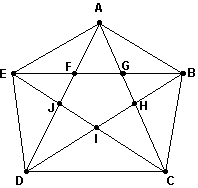
|
| 9. |
For the graph below, what is the cost of the Hamiltonian circuit obtained by using the nearest-neighbor algorithm, starting at A?

|
| 10. |
For the graph below, what is the cost of the Hamiltonian circuit obtained by using the sorted-edges algorithm?
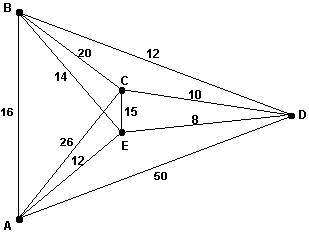
|
| 11. |
Use Kruskal's algorithm for minimum-cost spanning trees on the graph below. The cost of the tree found is:

|
| 12. |
If the order-requirement digraph for a collection of tasks is shown below, then what is the minimum completion time for the collection of tasks?
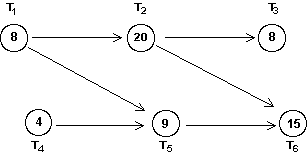
|
| 13. |
In which of the diagrams below do the wiggled edges represent spanning trees?
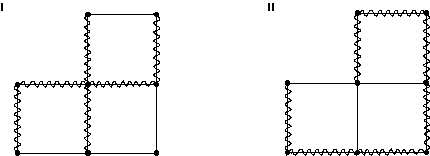
|
| 14. |
You want to create a mileage grid showing the distances between every pair of the 10 Canadian provincial/territorial capitals. How many numbers will you have to compute?
|
| 15. |
Given the order-requirement digraph below (with time given in minutes) and the priority list T1, T2, T 3, T4, T5, T6, apply the list-processing algorithm to construct a schedule using two processors. How much time does the resulting schedule require?
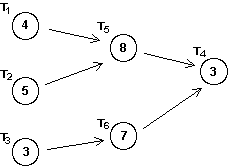
|
| 16. |
What is the minimum time required to perform six independent tasks with a total task time of 48 minutes on 3 machines?
|
| 17. |
Choose the packing that results from the use of the next fit (NF) bin-packing algorithm to pack the following weights into bins that can hold no more than 8 lbs.
 |
| 18. |
Choose the packing that results from the use of the first-fit decreasing (FFD) bin-packing algorithm to pack the following weights into bins that can hold no more than 8 lbs.
 |
| 19. |
Which of the following is a correct vertex coloring of the given graph? (Capital letters indicate which color the vertex is colored.)
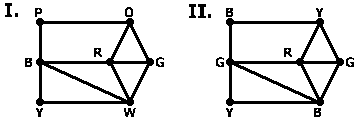
|
| 20. |
Find the chromatic number of the graph below:
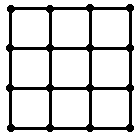
|
| 21. |
Write the constraint inequalities for this situation: Kim and Lynn produce pottery vases and bowls. A vase requires 35 oz. of clay and 5 oz. of glaze. A bowl requires 20 oz. of clay and 10 oz. of glaze. There are 500 oz. of clay available and 200 oz. of glaze available. The profit on one vase is $5 and the profit on one bowl is $4.
|
| 22. |
Graph the constraint inequalities for a linear programming problem shown below. Which feasible region shown is correct?
 |
| 23. |
The graph of the feasible region for a mixture problem is shown below. Find the point that maximizes the profit function P = 2x + y.
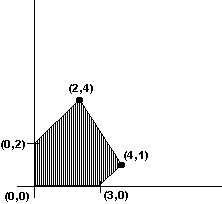
|
| 24. |
Find an initial solution using the Northwest Corner Rule and compute its total transportation cost.
|
| 25. |
Transport as many units of bread as possible through (Bakery1,Store3) and compute the improvement in total transportation cost. Adjust the numbers in the fields as necessary.
|
Answer Key
| 1. |
Staw Man: why does kids not running on the street im ply they have to be kept indoors?
Limited Choice: kids can be out, just not on the street. | ||||||||||||||||||||
| 2. | C | ||||||||||||||||||||
| 3. | B | ||||||||||||||||||||
| 4. | False | ||||||||||||||||||||
| 5. | A | ||||||||||||||||||||
| 6. | B | ||||||||||||||||||||
| 7. |
c
| ||||||||||||||||||||
| 8. | D | ||||||||||||||||||||
| 9. | D | ||||||||||||||||||||
| 10. | D | ||||||||||||||||||||
| 11. | C | ||||||||||||||||||||
| 12. | B | ||||||||||||||||||||
| 13. | B | ||||||||||||||||||||
| 14. | C | ||||||||||||||||||||
| 15. | C | ||||||||||||||||||||
| 16. | C | ||||||||||||||||||||
| 17. |
a
| ||||||||||||||||||||
| 18. |
b
| ||||||||||||||||||||
| 19. | C | ||||||||||||||||||||
| 20. | D | ||||||||||||||||||||
| 21. | C | ||||||||||||||||||||
| 22. |
A
| ||||||||||||||||||||
| 23. | C | ||||||||||||||||||||
| 24. |
Transportation Cost: 3*3+2*1+3*5+3*4 = 38 | ||||||||||||||||||||
| 25. |
Change in Transportation cost: |